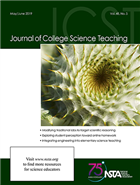Ideas and inspiration from NSTA journals
By Mary Bigelow
Posted on 2019-05-09
Sometimes it seems like there are artificial boundaries in education: elementary vs. secondary, K-12 vs. higher education, middle school vs. high school. Having been an educator at all of these levels, I’ve found that there are more similarities than differences. If you take a few minutes to browse the table of contents for the journals that are outside your own teaching assignments (or read the blogs) you might identify a few articles of interest to download and read. For example, if you need a refresher on content, the secondary journals may help you. You may have students who could benefit from more advanced activities or students who need more fundamental experiences. You can see what the NGSS “looks like” at different grade levels. And get ideas for investigations that could be adapted for your grade level.
The Journal of College Science Teaching is another excellent NSTA resource with food for thought. It’s interesting that some of the articles in this higher education publication are about topics and issues with which K-12 teachers can identify, such as assessments, homework, the use of technology, and investigations. Even though the students described in these articles are older and more experienced, there are a lot of commonalities with science education at all levels. Best of all, unlike some higher education publications, the articles in JCST are very readable, not written in heavy “journalese.”
For example, in this year’s issues there have been articles about
- Organizing a course around a “big picture“
- Improving skills in using microscopes
- Helping preservice teachers analyze lessons for NGSS three-dimensional thinking
- Integrating technical writing in the laboratory
- Virtual vs face-to-face labs
- Difference between engagement and understanding
- Impacts of PowerPoint on learning
- Using the 5E format to create lessons from science research projects
- Practicing skills to enhance higher-order thinking
- Working with underrepresented students in science
- Modifying a traditional lab to enhance scientific reasoning
As an NSTA member you can download articles from all four journals as PDFs directly to your device. Or you can take advantage of NSTA’s Learning Center to save relevant articles in your own online library or organize them into a resource collection to share with colleagues.
Disclaimer: The views expressed in this blog post are those of the author(s) and do not necessarily reflect the official position of the National Science Teaching Association (NSTA).


